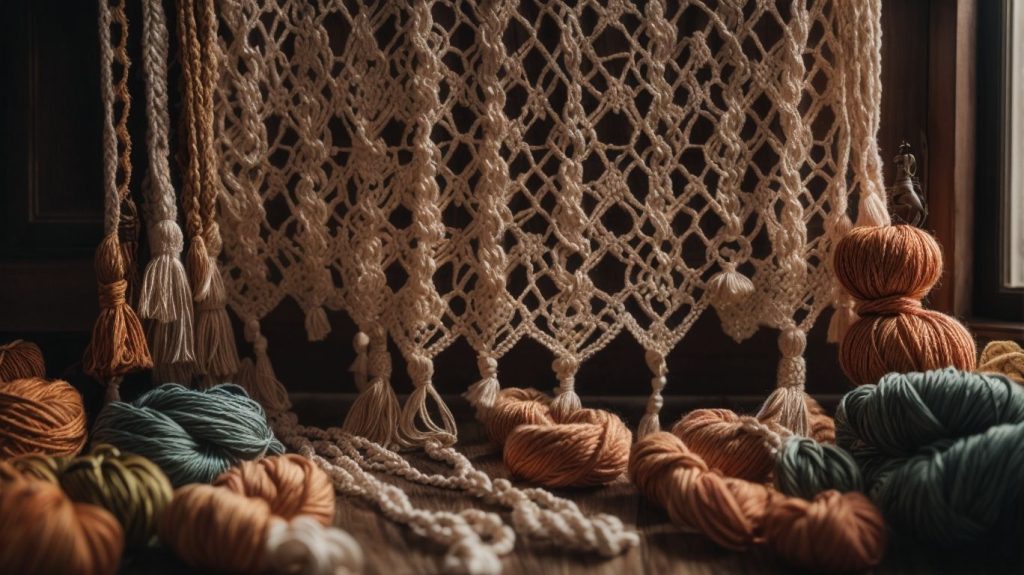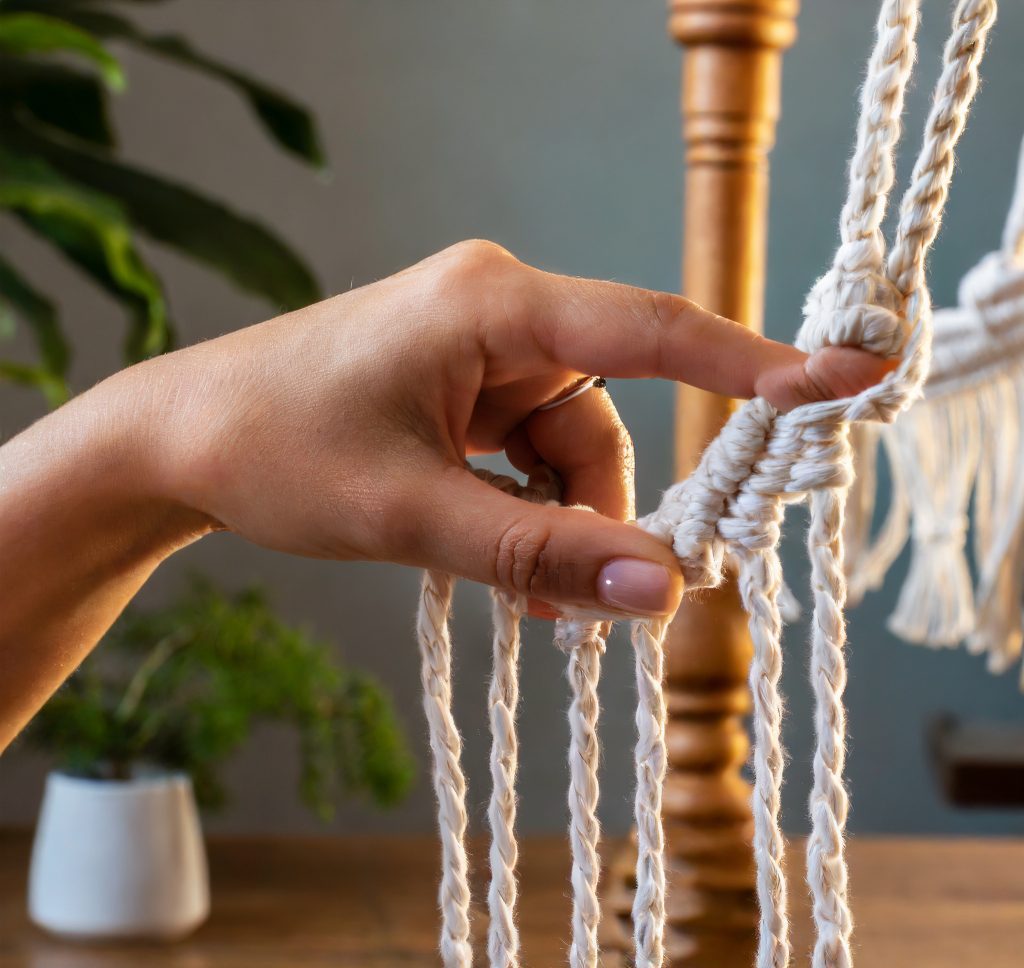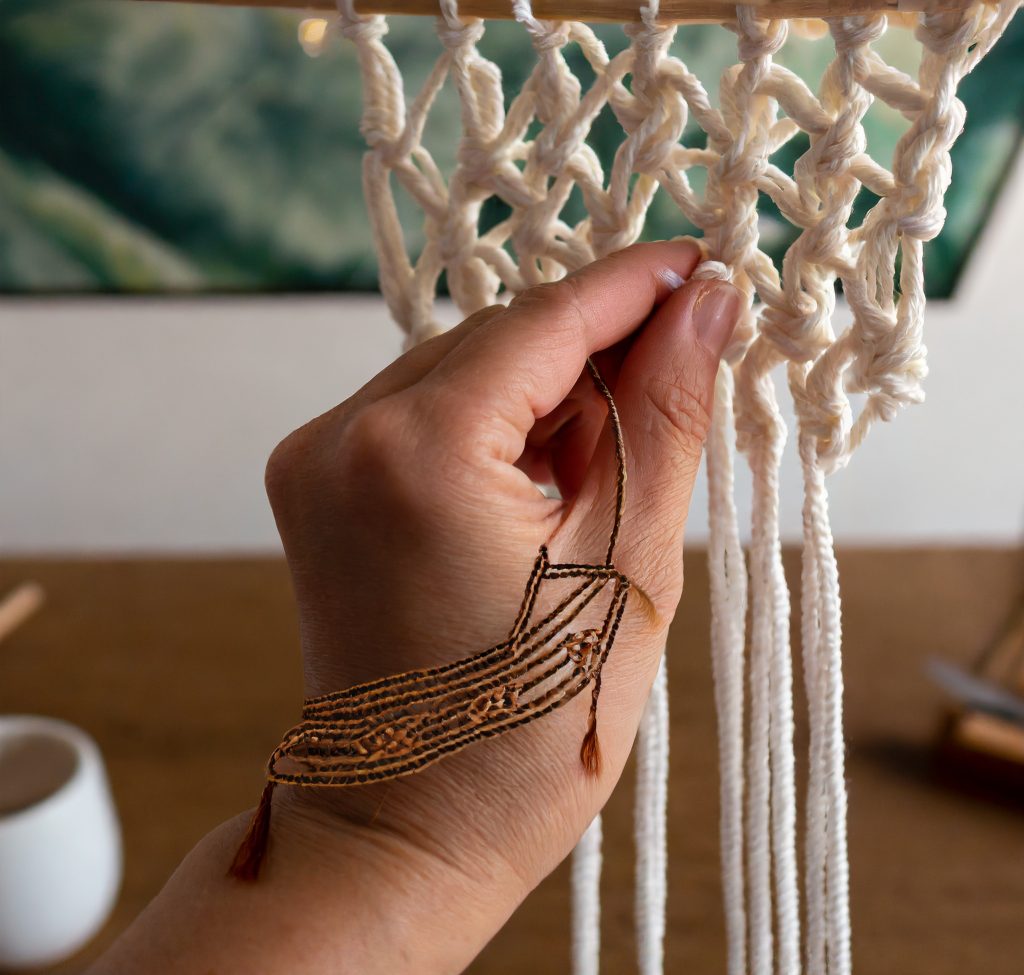Macrame: an intricate form of art. We’ll explore the fascinating world of it, its common mistakes, and how to fix them.
Start by familiarizing yourself with the basic techniques and materials. Different types of knots and their applications, plus the right cord material for desired results.
Common mistake: using cords that are too thick or thin. Thick can be bulky, thin lack strength/durability. Balance between thickness/flexibility is key.
Also, improper tensioning of knots. Maintain consistent tension throughout – not too tight or it will distort shape.
For complex patterns, keep track of each cord’s position/direction. Tangled cords or errors in knot placement can lead to an unbalanced/flawed final product. Label/color-code cords for efficiency.
Practice makes perfect. Mistakes are opportunities to learn and grow as an artist. Allow creativity while staying true to the fundamentals.
Grab your cords and start your macrame adventure! Be aware of common mistakes and use the fixes – you’ll be a true master in no time. Happy knotting!
Common Mistakes in Macrame
To create flawless macrame pieces, mastering the art of macrame requires addressing the common mistakes that beginners often make. In order to tackle these issues efficiently, this section will guide you through the solutions for each mistake: using the wrong type of cord, maintaining incorrect tension, and ensuring consistent knotting.
Mistake 1: Using the wrong type of cord
Using the wrong type of cord in macrame can cause disappointing results. So, to get the perfect look and feel for your project, consider these tips:
- Choose the correct material – Nylon is great for beginners, cotton for a softer look, and jute for rustic charm.
- Think thickness – think big for bolder knots and thin for intricate designs.
- Check durability – make sure the cord you choose can support the weight of your project.
- Pick the perfect colour – to complement the design, use a contrasting or monochromatic colour.
For macramé newbies, here’s what to do:
- Research and compare cords online or at craft stores.
- Read reviews or ask experienced macrame artists for advice.
- Experiment with different types of cords.
Doing your due diligence and experimenting will ensure you know exactly which cords work best for your project. Keep in mind, that practice makes perfect, so don’t be afraid to make mistakes and learn from them! After all, you want to get the right tension, not a slinky that’s lost its bounce.
Mistake 2: Incorrect tension
Incorrect tension is a common blunder in macrame. To get the desired result, the right tension is essential when working on macrame projects. We’ll go through a step-by-step guide on how to dodge this mistake and get the perfect tension in your macrame.
- Choose the right material for your macrame project. Different materials have distinct features, so pick one that fits your design and provides stability.
- Measure and cut the cord or rope according to the required length before beginning. This will help you maintain tension throughout.
- As you knot, pay close attention to the tension of each knot. Pull too tightly, and your work will buckle or become distorted. Too loose, and the knots won’t hold their shape.
- Check the tension as you go. Adjust if needed to keep uniformity in your macrame piece.
- Practice! The more you do macrame, the better sense you’ll develop for achieving the ideal tension. Over time, you’ll be able to adjust the tension without thinking.
Keep a relaxed but firm grip on your cords too – this can help you maintain the correct tension during your project. Use these tips and you can avoid the mistake of incorrect tension and make stunning macrame pieces with ease.
Studying further techniques can help you understand how to get the best results in macrame and enhance your skills.
Fascinating Fact: Macramé originated in ancient Babylonian and Assyrian civilizations where it was used mainly for decorations (Source: Craft Curator).
No matter your skill level, consistency is essential in macrame – unless you want your design to look like a knotty mess.
Mistake 3: Inconsistent knotting
Inconsistent knotting can have a big effect on a macrame project’s look and durability. It’s important to keep knotting consistent to make a beautiful piece. Uneven tension, weak structure, and lack of visual appeal are all caused by inconsistent knotting.
To avoid this, pay attention to each knot you make. Make sure they are tied with the same tightness. Practicing will also help you get better at knotting consistently.
Beginners can find knotting inconsistent especially difficult. It takes patience and practice to form muscle memory for consistent knotting. Different types of knots can also lead to inconsistency if not done uniformly.
Macrame has grown in popularity due to its beauty and flexibility. Still, even experienced macramers make this mistake. Knowing the importance of consistent knotting and practicing can help you overcome this and make stunning pieces!
How to Fix Mistake 1: Choosing the right cord
To fix the mistake of choosing the wrong cord in macrame, explore the types of cord available and their specific uses. Discover helpful tips for selecting the right cord that suits your macrame project. Explanation of different cord types and tips for cord selection will provide the solution you need.
Explanation of different types of cord and their uses
Cords come in various types, each with its own purpose. It’s important to know the uses of cords to avoid mistakes when choosing one. Let’s explore the details!
Check out the table below for an overview of different cord types and their uses:
Cord Type: Nylon
Uses: Outdoor activities, camping
Cord Type: Cotton
Uses: Crafting, macramé
Cord Type: Jute
Uses: Gardening, upholstery
Cord Type: Elastic
Uses: Clothing, sewing projects
Cord Type: Paracord
Uses: Survival situations
Now that we have an idea of the basics, let’s talk about details.
Each type of cord is designed to serve its purpose. For example, nylon cords are great for outdoor activities because they are durable and resistant to moisture. Cotton cords are perfect for crafting intricate designs or macramé projects.
To show how important it is to choose the right cord, here’s a story. A friend of mine went on a hiking trip without considering the importance of choosing the right cord. While rappelling down a cliff, his cord snapped. Fortunately, a hiker nearby had a paracord, which saved him from danger.
This shows that paying attention to these distinctions is key to picking the suitable cord for your intended use. Choose the right cord, or your project will unravel faster than a cheap sweater.
Tips for selecting the appropriate cord for your project
Selecting the right cord for your project is essential. The perfect cord will ensure the success of your project with no troubles. Here are some tips to help you choose:
- Think about what the project needs: Electrical, decorative, or practical. This will reduce your options and help you pick the best one.
- Check the weight capacity: Different cords have different capacities. Choose one that can handle the weight of your project to prevent safety hazards.
- Measure the length: Measure the distance between your power source and where you will use the cord. Too short may limit it, too long can cause tripping.
- Examine the environment: Some cords are more resistant to moisture, heat, etc. Evaluate the conditions of use and pick a cord that can endure them.
- Look for safety certifications: Make sure the cord has been tested and approved by relevant safety organizations, so you know it meets standards.
- Compare prices and quality: Look at price and quality when selecting a cord. Investing in a high-quality cord saves from frequent replacements in the long run.
For special projects, consult experts or professionals who can guide you in choosing the right type of cord.
It wasn’t easy in ancient times. People had tried and failed to understand cord requirements, often causing accidents. It took years of experiments and technological advancements to get a better understanding. We are lucky today, with many cords to choose from that serve specific needs and guarantee optimal performance.
These tips, plus knowledge from the past, help you confidently pick the right cord for your project, ensuring success without any setbacks or safety compromises. And remember, tension is important in yoga and relationships – but only in a good way!
How to Fix Mistake 2: Achieving proper tension
To achieve proper tension in your macrame projects and fix mistake 2, utilize techniques for maintaining consistent tension and understand how to adjust tension in different macrame knots. These sub-sections will provide you with practical solutions to ensure your macrame masterpieces are perfectly balanced and visually appealing.
Techniques for maintaining consistent tension
Keeping tension consistent is vital for successful outcomes. Here are 6 ways to make sure tension is right:
- Inspect regularly: Check the tension of your materials all the way through the project, and be sure it remains the same.
- Check the bobbin: Match the tension of the bobbin to the top thread’s tension to avoid any mistakes in stitching.
- Change discs: Play around with the tension discs until you get an even stitching pattern.
- Test on scrap material: Before starting a new project, try the tension settings on a scrap fabric that looks like the project fabric.
- Choose the right thread & needle: The right thread and needle sizes can make a big difference in tension control. Choose ones that fit your project.
- Practice threading: Learning the correct threading methods will help keep tension consistent. Get guidance from instructional guides or experts if needed.
Plus, for better results:
- Keep your sewing machine in good condition to maintain steady tensions.
Source: Sewing Mastery
Adjusting tension in different macrame knots
Assess tension: Examine your macrame knots. Look for loose or uneven knots.
Make adjustments: Tighten loose knots by pulling on the working cords. Loosen tight knots using fingers or a crochet hook.
Test & refine: See if any sections feel loose or slack. Make further adjustments until tension is uniform.
Unique details: Pay attention to the type of cord used. Patience is key – work slowly and make small changes.
Pro Tip: Use steady hands when adjusting tension. Don’t pull too hard or abruptly. Gentle movements are best.
Untangling writing is like unknotting headphones – tedious, time-consuming, and tear-inducing!
How to Fix Mistake 3: Establishing consistent knotting
To establish consistent knotting in macrame, master the art by following step-by-step instructions for proper knotting technique. Additionally, troubleshoot common issues that arise when trying to achieve consistent knots. This comprehensive guide will help you become a macrame expert in no time.
Step-by-step instructions for proper knotting technique
Knot-tying mastery is a must for a perfect and secure outcome. Follow these steps to get consistent knots each time:
- Grip both ends of the string or rope firmly; give it enough slack.
- Cross the right over the left, forming an “X”.
- Take the right end again, cross it over the left, and thread it in the loop made by the “X”. Pull both ends firmly.
For supreme accuracy in knotting, consider these tips:
- Keep equal tension on both rope ends.
- If you’re using a special knot for a purpose, like a bowline or square knot, learn its steps and intricacies.
- Practicing is key! Regularly tying knots will help you gain skill and confidence.
Pro Tip: Test your knot’s strength and toughness by giving it a good tug before sealing it. A weak or loose knot can cause disasters or unraveling unexpectedly.
By following these steps and minding the small stuff, you’ll become an expert at consistent knotting. Remember, practice and attention to details are vital in mastering this important skill.
Troubleshooting tips for achieving consistent knots
Achieving consistent knots is essential for any rope-tying task. Here’s how to troubleshoot knots and ensure they stay secure:
- Use the correct technique. Know which knot is best for the job.
- Choose quality materials. Wear and tear weakens knots.
- Maintain tension. Too much or too little, and knots won’t hold.
- Practice. Perfecting knot-tying takes time.
Plus, pay attention to small details. These can make a big difference.
Max learned this lesson the hard way when he went camping. He followed instructions but didn’t keep the tension right. Unfortunately, he had to learn the hard way that even small mistakes can ruin your knots.
So, remember: A well-secured knot is like a loyal friend, unlike certain exes!
Conclusion
Finally, to become a macrame master, you need to focus and have lots of patience. Avoiding mistakes will help you design amazing pieces that will wow everyone. Unlock your full macrame potential with these extra resources. Soon, you will be weaving knots like a pro!
Additional Resources (optional)
We’ve already uncovered Macrame and its mistakes. But that’s not all! Here are more resources to help you on your Macrame journey:
- Online Tutorials: The internet is packed with Macrame tutorials. From basic knots to complex designs, the step-by-step instructions will help you become a master.
- Books and Magazines: For something more tangible, check out the books and magazines devoted to Macrame. They often have detailed patterns, tips, and inspiration from experienced Macrame artists.
- Workshops and Classes: If you want to learn in person, search for local Macrame workshops or classes. You can be part of a community of Macrame fans and get knowledge from an experienced teacher.
Ready to explore more with these resources? Let’s get started on your Macrame adventure today! Oh, and did you know Macrame dates back thousands of years? It was used by sailors at sea to make intricate knots with ropes. Now, it has evolved into a decorative craft.
Frequently Asked Questions
FAQ 1: Why is my macrame piece turning out uneven?
Uneven tension is often the culprit behind an uneven macrame piece. Make sure to consistently pull the cords taut after each knot, ensuring an even amount of pressure. Additionally, double-check your measurements and placement of knots to maintain symmetry.
FAQ 2: How can I prevent my macrame knots from unraveling?
To prevent knots from unraveling, ensure each knot is tied tightly and secured with a double knot. Apply a small amount of clear fabric glue to the base of the knot for added security. Once dry, trim any excess cord to achieve a neat and finished look.
FAQ 3: What should I do if I make a mistake in my macrame pattern?
If you make a mistake in your macrame pattern, don’t panic! Carefully undo the incorrect knot or section and retrace your steps. Take your time to ensure accuracy and consult instructional resources or online tutorials if needed. Practice and patience are key to mastering macrame.
FAQ 4: How do I fix gaps or holes in my macrame design?
To fix gaps or holes in your macrame design, you can add additional rows of knots or use smaller cords to fill the gaps. Alternatively, you can strategically place decorative beads or charms to camouflage any imperfections. Experiment with different techniques to find the best solution for your specific design.
FAQ 5: My macrame piece looks messy. How can I achieve a cleaner look?
To achieve a cleaner look in your macrame piece, take extra care with your tension and spacing between knots. Regularly comb through the cords using a fine-toothed comb or a brush to separate the fibers and eliminate any tangles. Additionally, trimming any excess cords neatly can result in a more polished appearance.
FAQ 6: How can I avoid wrist fatigue while working on a large macrame project?
Working on a large macrame project can strain your wrists. To avoid fatigue, take regular breaks to stretch and rest your hands and wrists. Consider using wrist support braces or ergonomic tools to reduce the risk of discomfort or injury. Listening to your body and pacing yourself will ensure an enjoyable macrame experience.












